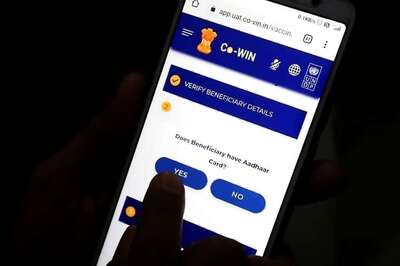
views
What is the trick to the Green Glass Door?
Only items with double letters are allowed to go through the door. Essentially, any object that has a double letter (“aa,” “bb,” “cc”) somewhere in its spelling can be brought through the Green Glass Door (get it now?), but any words that aren't spelled with a double letter can’t. Some examples of what can (and can’t) be brought through a green glass door include: Eggs, but not chickens A book, but not a page A seed, but not a plant A penny, but not a dime A wheel, but not a car Noodles, but not pasta
How to Play the Green Glass Door Game
Gather a group of 3 or more people to play the game. You only need a minimum of three people to play the game, and you can play even with a very large group of 20-30 people (as long as everyone is paying attention). Before playing, ask your guests if they know the Green Glass Door rule—if some of them do, that’s okay. They can help you by offering correct examples that will help other players guess the rule. If the majority of the group knows the trick, however, you may be better off playing a less well-known variation. The Green Glass Door game is often played as an icebreaker or team-building activity in classrooms, workplaces, and summer camps. It can also be played at parties or as a drinking game, when appropriate.
Tell the group one thing you can take through the door and one thing you can’t. You might say, “I can bring a tree through the Green Glass Door, but I can't bring a leaf.” Or, “I can bring a kitten through the Green Glass Door, but I can’t bring a cat.” Remember that the object of the game (for players) is to figure out what can be brought through the Green Glass Door. Giving them a non-example may confuse them at first, but it will also help them begin to figure out the rule.
Have other players take turns saying what they’ll bring through the door. Instruct players to say, “I’m bringing ___ through the Green Glass Door.” Players can name practically anything they want. The word they choose doesn’t actually have to be a tangible object. For example, things like “freedom,” “intellect,” or “gossip” could all theoretically go through the green door.
Tell players whether or not they can bring their item through the door. If a player says that they’re bringing something that contains double letters (like llama or earrings), then tell them that they can bring that through the door. If they say something that doesn’t contain double letters (like alpaca or necklace), tell them that they can’t bring their item. If someone isn’t allowed to bring their item, you can either continue play to the next person or give them a consequence, depending on what type of group you’re playing with. If you’re playing in a classroom setting, for instance, you could eliminate them from the game. If you’re playing at a party, you might ask the player to perform a dare. To turn this into a drinking game, ask the player to drink when they aren't allowed to bring their item. If you’re playing in a classroom, you may also want to write the list of allowed/disallowed items on a whiteboard or blackboard so that students can visually see and more easily figure out the Green Glass Door pattern.
If players get stuck, give them more examples and non-examples. It can sometimes take a while for players to figure out the rule, usually because they’re more focused on the relationship between the items rather than their spelling. If players are struggling, you (or players who already know the trick) can give hints involving two objects that do have a relationship, such as: Similar/synonymous objects: “You can bring stuff, but not things.” Opposite objects: “You can bring something smooth, but not something rough.” A whole and a part: “You can bring a wrapper, but not gum.” Related objects: “You can bring a pillow but not a blanket.” Paired objects: “You can bring a needle, but not thread.” Same-category objects: “You can bring a carrot, but not cauliflower.” Subtype objects: “You can bring a goose, but not a bird.” These hints may confuse players at first (which could make the game feel more fun for those in the know). But, the non-examples can also help them rule out potential patterns and start thinking more outside of the box.
If a player thinks they know the pattern, ask them for an example of an allowed item. Tell players that they should let you know once they think they’ve figured out the trick. However, ask them not to say the secret out loud—instead, ask them to give you a few examples of allowed items so that other players can continue the game.
The game ends when everyone has figured out the riddle. Once the last person has figured out the trick and can name a few items that are allowed to go through the Green Door, the game ends! This game doesn’t really have a loser or winner; it’s just a fun riddle game to break the ice or have fun at a party! If the group wants to continue playing, you’ll have to come up with a new rule—check out our section of possible variations, or try a similar brain-teasing game.
Green Glass Door Riddle Variations
Once everyone in your group knows the trick, come up with a new variation. The Green Glass Door game can only be played once according to its original rules since everyone will know the secret after one round. However, you can then play the game with a new pattern or trick, which either the same or a new host can come up with. Here are some ideas for new Green Glass Door patterns: Only items of a certain color. E.g., grass and kiwis for a “green” game but not plums or sand. Only items that require batteries. E.g, a laptop but not a computer. Only items that are plural. E.g., “dolphins” and “barrels,” but not “whale” or “bottle.” Only items that end in a vowel. E.g., “lime” and “coffee” but not “lemon” or “breakfast.” Only items that end in a consonant. E.g., “cat” and “man” but not “igloo” or “cobra.” Only items that are spelled with all vowels in alphabetical order (a, e, i, o, u). E.g., “hair” and “bison,” but not “weather” or “protein.” Only items whose words start with or contain other words. E.g., “bummer” or “cupcake” but not “fish” or “tacos.” Only items that share a first initial with the person speaking. E.g., Orla can bring an otter, but Aodhán can’t. Aodhán can bring an armchair, but Orla can’t. Only items that start with the first initial of the person sitting next to you. Any item as long as the person (accidentally or not) said “um” or “uh” while speaking. You can also tailor your variations to the group of people you’re with. If you’re hanging out with a group of people who all speak Spanish and English, for example, you could only allow in words that are cognates between both languages.
Similar Party & Icebreaker Games
Desert Island The Desert Island game is popular with teachers and follows almost the exact same rules as the Green Glass Door game, except the pattern is not necessarily double letters. In Desert Island, the game host tells players that they’re going to a desert island and everyone can come along but must bring something with them. Players offer items which are judged against a rule that only the host knows, just like the Green Glass Door game. If they say an item that fits the rule, they can come to the island and their word is added to a visual list. If they don’t, then they can’t come and must try again on a future turn. The game continues until someone guesses the rule. The rule in Desert Island can be any rule made by the host, including the ones used in Green Glass Door.
I’m Going On a Picnic… I’m Going on a Picnic follows the same rules as Green Glass Door, but the scenario is going on a picnic rather than going through a door. The host chooses a pattern (which can be anything, not just double letters), and players say, “I’m going on a picnic, and I’m bringing ____.” If their item follows the rule, they can go to the picnic. If it doesn’t, they must try again with a different item. You can also play with the variation that players must name items that would reasonably be expected as a picnic. However, this is not required and may increase the difficulty level.
Under My Umbrella Under My Umbrella is a riddle game similar to Green Glass Door. In Under My Umbrella, one person names something that can’t go under an umbrella, then something that can. The other players try to figure out what objects can and can’t go under the umbrella. Although Under My Umbrella can be played with any secret rule, the original game instructs that players can only bring an item if they say “um” before it. For example, someone might say, “Can I bring, um, a cake?” This object would be accepted under the umbrella. But if someone just said, “Can I bring a cake?” then they would be rejected.
Cosmic Number Cosmic Number is more of a riddle than a game, but it can still be a fun brainteaser to do as an icebreaker or with a group of friends. In this activity, the cosmic number is 4, and the goal of the game is to figure out why 4 is the cosmic number. To play, give the following sentences to the players all at once or one at a time to help them find the solution. 1 is 3, 3 is 5, 5 is 4, and 4 is the cosmic number 8 is 5, 5 is 4, and 4 is the cosmic number 2 is 3, 3 is 5, 5 is 4, and 4 is the cosmic number 15 is 7, 7 is 5, 5 is 4, and 4 is the cosmic number 9 is 4, and 4 is the cosmic number 18 is 8, 8 is 5, 5 is 4, and 4 is the cosmic number 17 is 9, 9 is 4, and 4 is the cosmic number 100 is 10, 10 is 3, 3 is 5, 5 is 4, and 4 is the cosmic number The solution: The number of letters in each number is equal to the next number in the sequence. For example, 1 is 3 (because “one” has three letters), 3 is 5 (because “three” has five letters), and 5 is 4 (because five has four letters). Four is the cosmic number because its value equals the number of letters.
Black Magic The goal of the Black Magic game is to figure out how two people are communicating “telepathically.” To play, secretly make yourself and a friend the “guesser” and the “spy.” Tell your friends (or group) that you can read each other’s minds. Have the guesser leave the room, taking a random player with them to ensure no cheating. Back in the room, the “spy” asks everyone else to pick any object in the room. Once the players agree on an object, the “guesser” is called back. The “spy” then asks the “guesser” a bunch of questions, like “Is it the white shoe?” “Is it that red book?” etc. The “guesser” will pretend to read the “spy’s” mind and answer “no” to all questions until the “spy” points out a black-colored object. The “guesser” will again say no, but they will know to say “yes” to the NEXT object pointed out, which the “spy” will make sure is the object that the group pointed out. Continue the game until everyone figures out the trick. To play this game, of course, the “guesser” and the “spy” must have discussed the trick beforehand and be the only ones who know how to play this game.




















Comments
0 comment